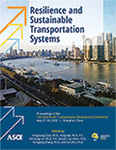13th Asia Pacific Transportation Development Conference
Effects of Autonomous and Automated Vehicles on Stopping Sight Distance and Vertical Curves in Geometric Design
Publication: Resilience and Sustainable Transportation Systems
ABSTRACT
Autonomous vehicles are expected to transform the existing transportation system into a safe and efficient future transportation system. The successful deployment and operation of these technologies depend largely on the roadway infrastructure. The existing infrastructure design and operational criteria were developed to meet the needs of human drivers which may not be optimal for AVs. Thus, automated vehicles require strategies that will improve the condition of the current roadway infrastructure before they can be deployed. It is essential to identify the potential changes to design and operational criteria of the roadway to maximize the potential benefits and to ensure successful deployment. This study investigates the impacts of automated vehicles on roadway geometric design elements and evaluates the potential changes in design and operational criteria. The primary focus of this study is the geometric design elements that will directly be affected by the transition from human-driven to fully autonomous vehicles. Stopping sight distance, and length of sag and crest vertical curves are geometric elements directly affected by the implementation of automated vehicles. Stopping sight distance is directly based on drivers’ PRT, in addition to the braking distance. Stopping sight distance will be evaluated using revised parameters to account for the impacts of AVs on highway design elements. Stopping sight distance, and length of sag and crest vertical curves computation will be performed to compare the current model value to the proposed values. Proposed values for these design elements will be presented and their effects will be quantified using quantitative assessment. The current design criteria will be compared with the newly proposed values. Compared with the existing ones, the proposed designs are more economical because shorten curves in general reduce the construction cost by reducing the required earthen work.
Get full access to this article
View all available purchase options and get full access to this chapter.
REFERENCES
AASHTO (2011). A Guide on Geometric Design of Highways and Streets, 6th Ed., American Association of State Highway and Transportation Officials, Washington, DC.
Charles, J. (2017). Readiness of the road network for connected and autonomous vehicles. Retrieved from http://www.racfoundation.org/research/mobility/readiness-of-the-road-network-for-connected-and-autonomous-vehicles
Durth, W., Bernhard, M., 2000. Revised Design Parameters for Stopping Sight Distance. Second International Symposium on Highway Geometric Design, 410-421.0.
Fambro, D. K., Fitzpatrick, K., and Koppa, R.J., “Determination of Stopping Sight Distances,” NCHRP, Report 400, Transportation Research Board, Washington, DC, 1997
Gigabit (2018). Understanding SAE Automated Driving. Retrieved from https://www.gigabitmagazine.com/ai/understanding-sae-automated-driving-levels-0-5-explained
HDL-64E S3, User’s manual and programming guide: high definition LiDAR sensor, velodyne LiDAR, 2017. Retrieved from https://velodynelidar.com/lidar/products/manual/HDL-64E%20S3%20manual.pdf
John, K., Kamar, A., Rima, A. (2010). An Initial Investigation of the Effects of a gully automated Fleet on Geometric Design. Retrieved from https://www.hindawi.com/journals/jat/2019/6126408/
Litman, T. (2017). Autonomous Vehicle Implementation Predictions Implications for Transport Planning. Victoria Transport Policy Institute. Retrieved from www.vtpi.org/avip.pdf
Parth, B., Kakan, D., Mashrun, C., and Plaban, D. (2017). Risk Analysis of Autonomous Vehicles in Mixed Traffic Streams. University Transportation Research Center, New York, NY.
Public Sector Consultants (PSC) and Center for Automotive Research (CAR) (2017). Planning for Connected and Automated Vehicles. Retrieved from https://www.cargroup.org/wp-content/uploads/2017/03/Planning-for-Connected-and-Automated-Vehicles-Report.pdf
Roadway Design Manual (2018). Vertical Alignment. Retrieved from http://onlinemanuals.dot.state.tx.us/txdotmanuals/rdw/vertical_alignment.htm
Rosen, E., Kallhammer, J., Eriksson, D., Nentwich, M., Fredriksson, R., and Smith, K. (2010). Pedestrian injury mitigation by autonomous braking. Retrieved from http://www.sciencedirect.com/science/article/B6V5S-50D0TV5-1/2/e7e2b4ef4188a0d240a4ac4fae4cc33d
Kandarpa, R. (2018). Assessing the Impacts of Connected, Automated and Autonomous Vehicles on the Future of Transportation Safety. NCHRP active project 17-91. Transportation Research Board.
Waymo (2017). On the Road to fully self-driving. Retrieved from https://www.mtfchallenge.org/wp-content/uploads/2017/02/waymo-safety-report-2017-10.pdf
Information & Authors
Information
Published In
Resilience and Sustainable Transportation Systems
Pages: 715 - 724
Editors: Fengxiang Qiao, Ph.D., Texas Southern University, Yong Bai, Ph.D., Marquette University, Pei-Sung Lin, Ph.D., University of South Florida, Steven I Jy Chien, Ph.D., New Jersey Institute of Technology, Yongping Zhang, Ph.D., California State Polytechnic University, and Lin Zhu, Ph.D., Shanghai University of Engineering Science
ISBN (Online): 978-0-7844-8290-2
Copyright
© 2020 American Society of Civil Engineers.
History
Published online: Jun 29, 2020
Published in print: Jun 29, 2020
Authors
Metrics & Citations
Metrics
Citations
Download citation
If you have the appropriate software installed, you can download article citation data to the citation manager of your choice. Simply select your manager software from the list below and click Download.
